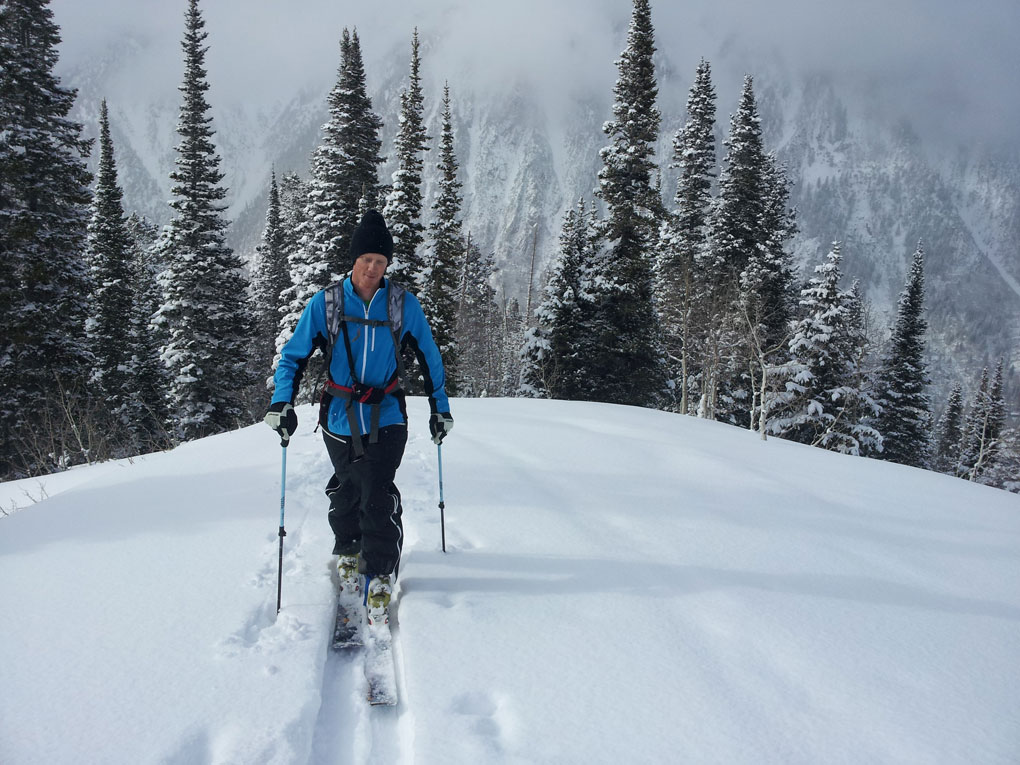Warmth
Icebreaker’s description of the Blast jacket states it is intended for “cooler days,” and, for the most part, my experience aligns with that statement. The caveat is that you must be active for the jacket to be very helpful; it is not a replacement for a light puffy or fleece to relax in.
As noted in the breathability section, the jacket does feel like it “traps” a certain amount of heat (and moisture), which might not be the best when it’s warm and you’re super active, but which does work well for when it is cold and you are active. I have, surprisingly, been warmer skiing Alta on cold days (10 to 20 F / -12 to -6 C) while wearing the Blast jacket under my Oakley Unification Pro shell than on similar days wearing the Scott Decoder puffy/fleece under the same shell.
As I expected, the Blast jacket has worked extremely well as an outer layer for the climbing portion of ski touring, especially with the temps between 20 to 45 F (-6 to 7 C). In this range and with moderate physical output, I have been very comfortable with only a long-sleeve base layer under the Blast jacket—my favorite in this application being the Icebreaker Sprint L/S because of its lightweight, wicking ability, and breathability.
I must add as well, I only say climbing portion because I have preferred the added protection of a bigger shell for the descents because of snow conditions, but will definitely be using the Blast as my only outer layer for spring touring.

The optimal temperature range I have found for mountain biking is a bit higher, with the Blast being really comfortable for me between 30 and 55 F (-1 to 12 C). As I mentioned in the “Fit” section, however, the short sleeves and lack of thumbholes can make the jacket a little drafty up the arms and into the chest area at speed when it’s really chilly out.
Weather Protection
Icebreaker strays from their typical sole composition of merino wool with the Blast jacket to increase its ability to protect the user from the elements, specifically wind and light precipitation.
Using the jacket almost daily for two months now, I have been very pleased with the amount of protection the Blast provides in these areas. I wouldn’t want to be caught in moderate to heavy rain, as the water repellency would certainly be overwhelmed, but on all occasions in mist, light rain, and warm, wet snowfall, the jacket has done an acceptable job of keeping moisture away from my body.
The material also provides excellent protection from the wind, which I thoroughly tested while hiking up and skiing the Baldy Chutes at Alta, and more recently while mountain biking in Fruita after a strong cold front pushed through.
The take-home message in this department is that the Blast is a great first-line boost in protection in addition to a normal base layer piece. It is perfect to throw on if you only need wind protection, if it’s threatening to precipitate, or is in fact lightly precipitating.
Packability
Packability may not be much of a concern for runners, but for ski touring and mountain biking, it is certainly an area to consider. While the jacket doesn’t pack down as well as a down insulator or an unlined shell, it is comparable to a lightweight fleece, and hasn’t been an area of concern for me. For a combination protection / insulation piece, I feel the Blast’s packability is very acceptable.
Durability
I have been wearing the Blast jacket nearly every day for the past couple of months now, and I am confident in the quality of the jacket. As I mentioned earlier, the zippers are phenomenal and are still working perfectly. All of the seams look as well-sewn as the day the jacket arrived, and even with all of my use with the Blast tucked in under a shell, the fabric shows absolutely zero signs of wear in the normal spots around the waist.
The material has also held up well to abuse while mountain biking, including the numerous scrapes the jacket receives through the insides of corners while rallying down some of the Corner Canyon area trails.
Bottom Line
My experience suggests that the cut of the Icebreaker Blast jacket was designed with a bit more of a focus on standing sports like running, hiking, and ski touring than for the seated, arms-forward activity of cycling. But if your arms are shorter or your shoulders are narrower than mine, you might feel differently.
With a MSRP of $250, there are a number of lightweight, soft-shell jackets for running and cycling that cost $50-$100 less than the Blast. Without those products in hand, I can’t compare their performance, but what I can say that the Blast does everything as advertised.
It is perfect for someone looking for wind and light water / snow protection along with a bit of added insulation. For running, cycling, or skiing in very cold temperatures, however, a heavier insulator will be a better option.

Things are usually much more expensive in New Zealand, but this jacket is currently NZ$210 (US$170’ish) at bivouac.co.nz – with free international shipping.